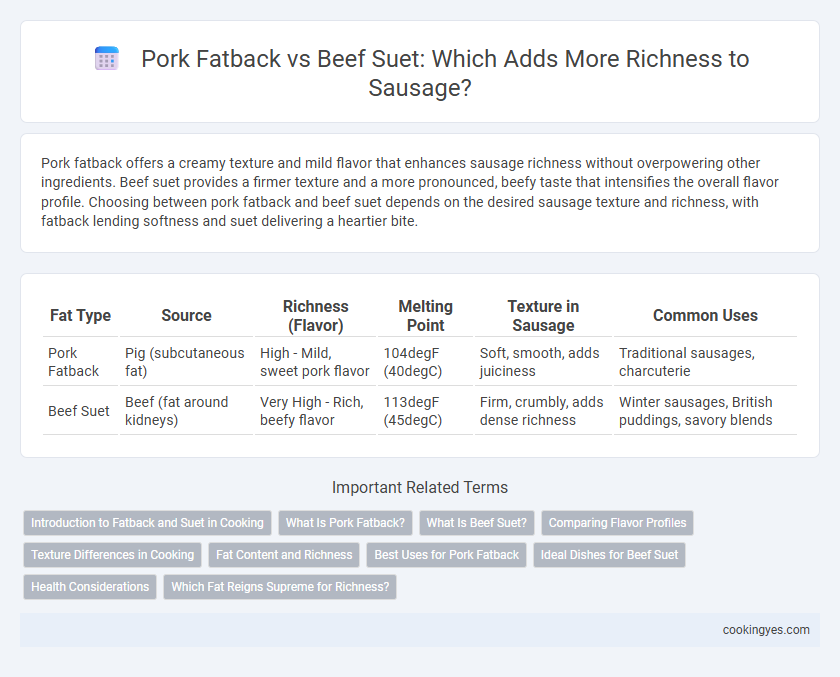Pork fatback offers a creamy texture and mild flavor that enhances sausage richness without overpowering other ingredients. Beef suet provides a firmer texture and a more pronounced, beefy taste that intensifies the overall flavor profile. Choosing between pork fatback and beef suet depends on the desired sausage texture and richness, with fatback lending softness and suet delivering a heartier bite.
Table of Comparison
| Fat Type | Source | Richness (Flavor) | Melting Point | Texture in Sausage | Common Uses |
|---|---|---|---|---|---|
| Pork Fatback | Pig (subcutaneous fat) | High - Mild, sweet pork flavor | 104degF (40degC) | Soft, smooth, adds juiciness | Traditional sausages, charcuterie |
| Beef Suet | Beef (fat around kidneys) | Very High - Rich, beefy flavor | 113degF (45degC) | Firm, crumbly, adds dense richness | Winter sausages, British puddings, savory blends |
Introduction to Fatback and Suet in Cooking
Pork fatback, a solid layer of fat from the pig's back, provides a mild, creamy richness and smooth texture essential for tender and flavorful sausages. Beef suet, derived from the kidney fat around the kidneys, is harder and offers a stronger, beefier flavor that enhances heartier sausage recipes. Both fats play crucial roles in balancing moisture and mouthfeel, with fatback favored for delicate blends and suet for robust, dense sausages.
What Is Pork Fatback?
Pork fatback is a layer of pure fat found beneath the skin of a pig's back, prized for its smooth texture and mild flavor, making it ideal for adding richness to sausages. Unlike beef suet, which has a firmer, waxier consistency and a stronger taste, pork fatback renders more evenly, enhancing the moistness and mouthfeel of sausage blends. Its high fat content, typically around 70-80%, contributes to juicy, flavorful sausages without overpowering the meat's natural taste.
What Is Beef Suet?
Beef suet is the hard fat found around the kidneys and loins of cattle, prized for its high melting point and rich, creamy texture that adds moisture and flavor to sausages. Compared to pork fatback, beef suet is firmer and renders more slowly, contributing a denser richness and a distinctive beefy flavor profile ideal for hearty sausage varieties. Its unique fat composition enhances the overall mouthfeel and juiciness, making it a valuable ingredient for traditional sausage recipes seeking depth and complexity.
Comparing Flavor Profiles
Pork fatback offers a mild, creamy richness with subtle pork undertones that enhance sausage juiciness and texture. Beef suet provides a robust, beefy flavor that adds depth and a slightly firmer mouthfeel, ideal for heartier sausage varieties. Choosing between the two depends on the desired flavor intensity and the specific sausage recipe profile.
Texture Differences in Cooking
Pork fatback provides a tender, smooth texture that melts evenly into sausage, enhancing juiciness and mouthfeel. Beef suet, in contrast, has a coarser, firmer consistency that renders a denser bite and a slightly crumbly texture in cooked sausages. Choosing pork fatback results in a softer, more cohesive sausage, while beef suet creates a heartier, more textured product.
Fat Content and Richness
Pork fatback contains approximately 85-90% fat, offering a smooth texture and mild flavor that enhances sausage richness without overpowering the meat. Beef suet, with a slightly higher fat content around 90-95%, provides a denser, beefier taste and firmer texture, contributing to a richer and more robust sausage profile. Choosing between pork fatback and beef suet depends on the desired balance of fatty moisture and flavor intensity in the final sausage product.
Best Uses for Pork Fatback
Pork fatback offers a smooth, mild flavor and firm texture that enhances sausage richness without overpowering the meat, making it ideal for finely textured sausages like Italian and breakfast varieties. It provides consistent moisture retention and a balanced fat-to-lean ratio crucial for emulsified sausages and charcuterie. Unlike beef suet, which is waxier and stronger in flavor, pork fatback ensures a tender bite and superior mouthfeel in traditional pork-based sausages.
Ideal Dishes for Beef Suet
Beef suet, with its high melting point and clean, neutral flavor, is ideal for enhancing the richness and tenderness of traditional British dishes like steak and kidney pudding, spotted dick, and savory meat pies. Its dense texture renders slowly, providing a moist and juicy consistency that complements robust beef and game recipes. Pork fatback, while flavorful and slightly sweeter, suits sausages and charcuterie where a softer fat blend is preferred for a finer grain and balanced taste.
Health Considerations
Pork fatback and beef suet differ significantly in their fatty acid profiles, impacting health considerations in sausage making. Pork fatback contains higher monounsaturated fats, which may contribute to better heart health, while beef suet is richer in saturated fats that can raise LDL cholesterol levels. Choosing pork fatback offers a balance of richness and a potentially healthier lipid profile, important for consumers mindful of cardiovascular risks.
Which Fat Reigns Supreme for Richness?
Pork fatback delivers a smooth, creamy texture with a mild flavor that enriches sausage by providing succulence and moisture, making it the preferred fat for traditional pork sausages. Beef suet, known for its firmer consistency and robust, savory taste, imparts a heartier richness often favored in specialty and game sausages. When evaluating richness, pork fatback typically reigns supreme due to its balanced fat composition that enhances juiciness and mouthfeel without overpowering the sausage's flavor profile.
Pork fatback vs beef suet for richness Infographic

 cookingyes.com
cookingyes.com